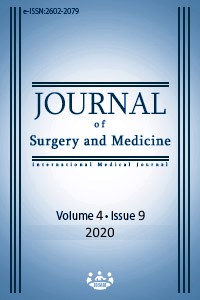The association between red cell distribution width to total calcium ratio and syntax score in patients with acute coronary syndrome
Keywords:
Acute coronary syndrome, serum calcium, red cell distribution widthAbstract
Aim: The relationship of both red blood cell distribution width (RDW) and Syntax risk score with prognosis and mortality in patients with acute coronary syndrome (ACS) has been shown. Besides, there is insufficient information about the use of red cell distribution width to total serum calcium (RDW-to-TSC) ratio in patients with ACS. We aimed to research the relationship between RDW-to-TSC and Syntax risk scores in our study. Methods: For our retrospective cohort study, 270 patients hospitalized in the cardiology intensive care unit with the diagnosis of myocardial infarction between January 2019 and December 2019 were screened. A total of 115 patients who were eligible were included in the study. The patients were classified into two groups: 58 had NSTE-ACS and 57 had STEMI. The included age range was 18-80 years. RDW-to-TSC was calculated as the ratio of red cell distribution width to total serum calcium count. By using Pearson's correlation analysis, the relationship between RDW-TAF ratio and Syntax score was obtained. Results: Among 115 patients, there were 50 males (43.5%), and 65 females (56.5%). The mean age was 58.09 (9.55) years. There were more hypertensive patients in the NSTE-ACS group (P=0.003). There was no statistically significant difference in RDW-to-TSC ratio between the two groups (P=0.809). The correlation of RDW and RDW / TSC ratio with syntax score were statistically significant (P<0.001). Conclusions: RDW-to-TSC ratio is a simple, cost-effective, and readily available test in all health centers. This may be used as a risk calculation tool like the Syntax score for patients with ACS.
Downloads
References
Wang TKM, Grey C, Jiang Y, Jackson RT2, Kerr AJ. Nationwide trends in acute coronary syndrome by subtype in New Zealand 2006-2016. Heart. 2020;106:221-7.
Lang Y, Ran X, Wang L. [Risk Factors of Death in Patients with Acute ST-segment Elevation Myocardial Infarction after PCI and the Combined Application of CTRP-1 with GRACE Score in Prognosis Evaluation of PCI Treated Patients]. Sichuan Da Xue Xue Bao Yi Xue Ban. 2019;50:941-5.
Kang J, Han JK, Kang DY, Zheng C, Jang HG, Park KW, et al. SYNTAX Score and SYNTAX Score II Can Predict the Clinical Outcomes of Patients with Left Main and/or 3-Vessel Disease Undergoing Percutaneous Coronary Intervention in the Contemporary Cobalt-Chromium Everolimus-Eluting Stent Era. Korean Circ J. 2020;50:22-34.
Huang J, Zhang Q, Wang R, Ji H, Chen J, Quan X, et al. Systemic Immune-Inflammatory Index Predicts Clinical Outcomes for Elderly Patients with Acute Myocardial Infarction Receiving Percutaneous Coronary Intervention. Med Sci Monit. 2019;25:9690-701.
Uthamalingam S, Patvardhan EA, Subramanian S, Ahmed W, Martin W, Daley M, et al. Utility of the neutrophil to lymphocyte ratio in predicting long-term outcomes in acute decompensated heart failure. Am J Cardiol. 2011;107:433-8.
Qian H, Luo Z, Xiao C, Chen J, Li D, Xu H, et al. Red cell distribution width in coronary heart disease: prediction of restenosis and its relationship with inflammatory markers and lipids. Postgrad Med J. 2018;94:489-94.
Neumann FJ, Sousa-Uva M, Ahlsson A, Alfonso F, Banning AP, Benedetto U, et all. 2018 ESC/EACTS Guidelines on myocardial revascularization. Eur Heart J. 2019;40:87-165.
Serruys PW, Onuma Y, Garg S, Sarno G, van den Brand M, Kappetein A-P, et al. Assessment of the SYNTAX score in the Syntax study. EuroIntervention. 2009;5(1) 50-6.
Barquera S, Pedroza-Tobías A, Medina C, Hernández-Barrera L, Bibbins-Domingo K, Lozano R, et al. Global Overview of the Epidemiology of Atherosclerotic Cardiovascular Disease. Arch Med Res. 2015;46:328-38.
Sullivan PG, Wallach JD, Ioannidis JP. Meta-Analysis Comparing Established Risk Prediction Models (EuroSCORE II, STS Score, and ACEF Score) for Perioperative Mortality During Cardiac Surgery. Am J Cardiol. 2016;118:1574-82
Agarwal S. Red cell distribution width, inflammatory markers and cardiorespiratory fitness: results from the National Health and Nutrition Examination Survey. Indian Heart J. 2012;64:380-7.
Nagula P, Karumuri S, Otikunta AN, Yerrabandi SRV. "Correlation of red blood cell distribution width with the severity of coronary artery disease-A single center study". Indian Heart J. 2017;69:757-61.
Magri CJ, Tian TX, Camilleri L, Xuereb R, Galea J, Fava S. Red blood cell distribution width and myocardial scar burden in coronary artery disease. Postgrad Med J. 2017;93:607-12.
Gravito-Soares M, Gravito-Soares E, Gomes D. Red cell distribution width and red cell distribution width to total serum calcium ratio as major predictors of severity and mortality in acute pancreatitis. BMC Gastroenterol. 2018;18:108.
Vogiatzis I, Samaras A, Grigoriadis S, Sdogkos E, Koutsampasopoulos K, Bostanitis I. The Mean Platelet Volume in the Prognosis of Coronary Artery Disease Severity and Risk Stratification of Acute Coronary Syndromes. Med Arch. 2019;73:76-80.
Downloads
- 484 877
Published
Issue
Section
How to Cite
License
Copyright (c) 2020 Uğur Küçük
This work is licensed under a Creative Commons Attribution-NonCommercial-NoDerivatives 4.0 International License.
















